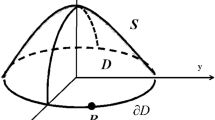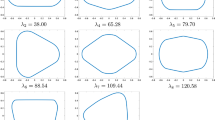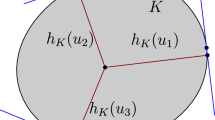Abstract
In this paper, a new approach is proposed for designing the nearly-optimal three dimensional symmetric shapes with desired physical center of mass. Herein, the main goal is to find such a shape whose image in (r, θ)-plane is a divided region into a fixed and variable part. The nearly optimal shape is characterized in two stages. Firstly, for each given domain, the nearly optimal surface is determined by changing the problem into a measure-theoretical one, replacing this with an equivalent infinite dimensional linear programming problem and approximating schemes; then, a suitable function that offers the optimal value of the objective function for any admissible given domain is defined. In the second stage, by applying a standard optimization method, the global minimizer surface and its related domain will be obtained whose smoothness is considered by applying outlier detection and smooth fitting methods. Finally, numerical examples are presented and the results are compared to show the advantages of the proposed approach.
Similar content being viewed by others
References
R. Butt, “Optimal shape design for differential inequalities,” PhD Thesis in Mathematics (University of Leeds, Leeds, 1988).
J. Haslinger and P. Neittaanmaki, Finite Element Approximation for Optimal Shape Design: Theory and Application (Wiley, New York, 1988).
O. Pironneau, “On optimal design in fluid mechanics,” J. Fluid Mech. 64, 97–110 (1974).
O. Pironneau, Optimal Shape Design for Elliptic Systems (Springer-Verlag, New York, 1983).
R. W. Ferguson, “Modeling orientation effects in symmetry detection: The role of visual structure,” Proceedings of the 22nd Annual Conference of the Cognitive Science Society (Inst. Res. Cognitive Sci. Univ. of Pennsylvania, Philadelphia, 2000), pp. 125–130.
D. Reisfeld, H. Wolfson, and Y. Yeshurun, “Context-free attentional operators: The generalized symmetry transform,” Int. J. Comput. Vision 14, (2) 119–130 (1995).
H. Zabrodsky, S. Peleg, and D. Avnir, “Completion of occluded shapes using symmetry,” Computer Society Conference on Computer Vision and Pattern Recognition (1993), pp. 678–679.
M. Kazhdan, B. Chazelle, D. Dobkin, T. Funkhouser, and S. Rusinkiewicz, “A reflective symmetry descriptor for 3D models,” Algorithmica, 38 (1), 201–225 (2004).
P. M. Van, Space Tourism: Adventures in Earth Orbit and Beyond (Springer, New York, 2005).
D. I. Capuzzo, and H. Ishii, “Approximate solution of the Bellman equation of deterministic control theory,” Appl. Math. Optim. 102, 161–181 (1984).
R. J. DiPerna, “Convergence of approximate solutions to conservation laws,” Arch. Ration. Mech. 82, 27–70 (1983).
M. Stefan, Variational Models for Microstructure and Phase Transitions (Lecture at the C.I.M.E. summer school Calculus of variations and geometric evolution problems, 1998).
L. Tartar, “Compensated compactness and applications to partial differential equations,” Nonlinear Anal. Mech: Heriot Watt Symp. 39, 136–212 (1979).
M. Chipot and D. Kinderlehrer, “Equilibrium configurations of crystals,” Arch. Ration. Mech. 103, 237–277 (1988).
I. Fonseca, “Variational methods for elastic crystals,” Arch Ration. Mech. 97, 189–220 (1987).
E. Bonnetier and C. Conca, “Approximation of Young measures by functions and application to a problem of optimal design for plates with variable thickness,” Proc. R. Soc. Edinburgh, Sect. A 124, 399–422 (1994).
F. Maestre and P. Pedregal, “Quasiconvexification in 3D for a variational reformulation of an optimal design problem in conductivity,” Nonlinear Anal. 64, 1962–1976 (2006).
P. Pedregal, “Vector variational problems and applications to optimal design,” ESAIM Control Optim. Calc. Var. 11, 357–381 (2005).
J. E. Rubio, Control and Optimization: The Linear Treatment of Nonlinear Problems (Manchester Univ. Press, Manchester, 1986).
A. V. Kamyad, J. E. Rubio, and D. A. Wilson, “Optimal control of the multidimensional diffusion equation,” J. Optim. Theory Appl. 70, 191–209 (1991).
J. E. Rubio, “The global control of nonlinear elliptic equation,” J. Franklin Inst. 330 (1) 29–35 (1993).
A. Fakharzadeh, J., and J. E. Rubio, “Best domain for an elliptic problem in Cartesian coordinates by means of shape-measure,” Asian J. Control. 11, 536–554 (2009).
A. Fakharzadeh and J. E. Rubio, “Global solution of optimal shape design problems,” Z. Anal. Anwendungen 18, 143–155 (1999).
A. Fakharzadeh, J. and J. E. Rubio, “Shapes and measures,” IMA J. Math. Control Inf. 16, 207–220 (1999).
M. H. Mehneh, M. H. Farahi, and J. A. Eefahani, “On an optimal shape design problem to control a thermoelastic deformation under a prescribed thermal treatment,” Appl. Math. Model. 31, 663–675 (2007).
A. Fakharzadeh, J. and J. E. Rubio, “Shape-measure method for solving elliptic optimal shape problems (fixed control case),” Bull. Iran. Math. Soc. 27, 41–63 (2001).
A. Fakharzadeh, “A shape-measure method for solving free-boundary elliptic systems with boundary control function,” Iran. J. Numer. Anal. Optim. 3 (2), 47–65 (2013).
B. Mohammadi and O. Pironneau, Applied Shape Optimization for Fluids, 2nd ed. (Oxford Science, Oxford, 2010).
M. Andreodi, A. Janka, and J.-A. Desideri, “Free-form deformation parametrization for multi-level 3D shape optimization in aerodynamics,” Research Report (Inst. National de Recherch en Information et en Automatique, 2003).
G. Allalrf and F. Jouv, “A level-set method for variation and multiple loads structural optimization,” Comput. Methods Appl. Mech. Eng. 194, 3269–3290 (2005).
B. George, R. Thomas, L. Finney, D. Maurice, and G. Weir, Calculus and Analytic Geometry (Wiley, New York, 2001).
A. Fakharzadeh, J. and Z. Rafei, “Best minimizing algorithm for shape-measure method,” J. Math. Comput. Sci. 5, 176–184 (2012).
M. Alan, Electromagnetic Field: Sources and Media (Wiley, New York, 1978).
A. Fakharzadeh, J., “Finding the optimum domain of a nonlinear wave optimal control system by measures,” J. Appl. Math. Comput. 13, 183–194 (2003).
M. H. Farahi, A. H. Borzabadi, H. H. Mehne, and A. V. Kamyad, “Measure theoretical approach for optimal shape design of a nozzle,” J. Appl. Math. Comput. 17, 315–328 (2005).
H. L. Royden, Real Analysis, 3rd ed. (Macmillan, New York, 1988).
P. C. Rosenbloom, “Qudques classes de problems exteremaux,” Bull. Soc. Math. France 80, 183–216 (1952).
J. Nocedal and S. J. Wright, Numerical Optimization (Springer, New York, 2006).
H. A. Abbas, “Marriage in honey bees optimization (MBO): A haplometrosis polygynous swarming approach,” Congress on Evolutionary Computation (Seoul, Korea, 2001), pp. 207–214.
H. P. Kriegel, P. Kröger, E. Schubert, and A. Zimek, “LoOP: local outlier probabilities,” Proceedings of the 18th ACM Conference on Information and Knowledge Management, Hong Kong, China, November 2–6, 2009 (ACM, New York, 2009), pp. 1649–1652.
V. Barnett and T. Lewis, Outlier in Statistical Data (Wiley, New York, 1994).
D. Hawkins, Identification of Outliers (Chapman and Hall, London, 1980).
H. P. Kriegel, P. Kröger, and A. Zimek, Outlier Detection Techniques (Tutorial Notes) (KDD, Washington, DC, 2010).
MATH2071: LAB # 5: Norms, Errors, and Condition Numbers, Retrieved from http://www.math.pitt.edu/sussmanm/ 2071Spring08/lab05/, October 6, 2014.
D. R. Smith, Variational Methods in Optimization (Prentice-Hall, Englewood Cliffs, N.J, 1974).
Author information
Authors and Affiliations
Corresponding author
Additional information
The article is published in the original.
Rights and permissions
About this article
Cite this article
Alimorad D., H., Fakharzadeh J., A. A theoretical measure technique for determining 3D symmetric nearly optimal shapes with a given center of mass. Comput. Math. and Math. Phys. 57, 1225–1240 (2017). https://doi.org/10.1134/S0965542517070028
Received:
Accepted:
Published:
Issue Date:
DOI: https://doi.org/10.1134/S0965542517070028




